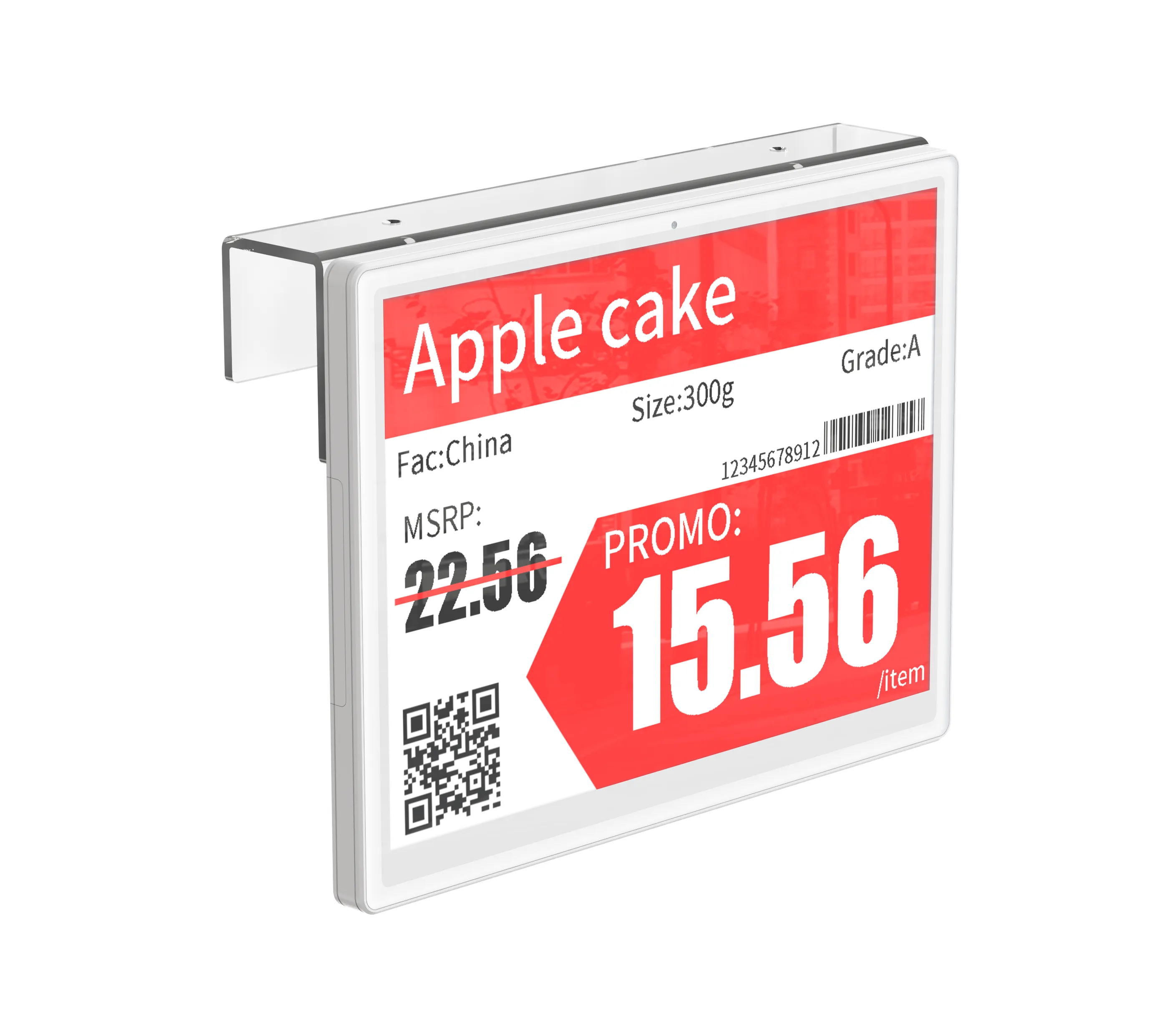လုပ်ငန်းများသည် ၎င်းတို့၏လုပ်ငန်းဆောင်တာများကို ထိရောက်စွာ စီမံခန့်ခွဲရန် ရှာဖွေနေသည့်အတွက် အလွယ်တကူ ဝယ်ယူနိုင်သော ဈေးကွက်သည် တော်လှန်ရေးဆန်သော ပြောင်းလဲမှုကို ကြုံတွေ့နေရပါသည်။ ဤပြောင်းလဲမှု၏ ဦးဆောင်နေရာတွင် ပေါ်လွင်ထင်ရှားသော ဒစ်ဂျစ်တယ်မျက်နှာပြင်များဖြင့် ရိုးရာစက္ကူစျေးနှုန်းတံဆိပ်များကို အစားထိုးနေသော နည်းပညာတစ်ခုဖြစ်သည့် စတိုးဆိုင်တန်းတွင် တပ်ဆင်သော တံဆိပ်အလိုအလျောက်စနစ် ဖြစ်ပြီး စျေးနှုန်းစီမံခန့်ခွဲမှုတွင် တိကျမှန်ကန်မှုကို ထိန်းသိမ်းရင်း လုပ်သားအင်အားကို အကောင်းဆုံးအသုံးချကာ လုပ်ငန်းဆောင်တာစရိတ်များကို လျှော့ချလိုသော စတိုးဆိုင်များအတွက် ဤတီထွင်မှုသည် အဓိကပြောင်းလဲမှုကို ဖြစ်ပေါ်စေနေပါသည်။
ခေတ်မီစျေးရောင်းသူများသည် အလုပ်သမားလုပ်အားခများ တိုးမြင့်လာခြင်းနှင့် စျေးနှုန်းများကို မကြာခဏ အပ်ဒိတ်လုပ်ရန် လိုအပ်ချက်များကို ရင်ဆိုင်ရင်း ယှဉ်ပြိုင်နိုင်စွမ်းကို ထိန်းသိမ်းရန် တိုးမြင့်လာသော ဖိအားများကို ရင်ဆိုင်နေရပါသည်။ လက်ဖြင့် စျေးနှုန်းပေါ်ကပ်ခြင်းသည် အလုပ်သမားအင်အားကို အသုံးများစေပြီး ဝန်ထမ်းများ၏ တန်ဖိုးရှိသော အချိန်များကို သုံးစွဲရာရောက်ပြီး လူသားအမှားများကို ဖြစ်ပေါ်စေနိုင်သည့် ရှည်လျားသော လုပ်ငန်းစဉ်ဖြစ်ပါသည်။ ရှယ်ဖ်တွင် တပ်ဆင်သော အလိုအလျောက် စျေးနှုန်းပြသည့်စနစ်သည် စျေးနှုန်းအပ်ဒိတ်လုပ်မှုကို ရိုးရှင်းစေပြီး ဝန်ထမ်းများကို ပိုမိုတန်ဖိုးရှိသော ဖောက်သည်နှင့် ထိတွေ့ဆက်ဆံမှုလုပ်ငန်းများတွင် အာရုံစိုက်နိုင်ရန် လွတ်မြောက်စေပါသည်။
စျေးဝယ်သူအများအား လွဲချော်တတ်ကြသည့် စာရွက်အပေါ်အခြေခံသော တံဆိပ်ကပ်စနစ်များသည် အလွန်ကြီးမားသော ဖုံးကွယ်ထားသည့် ကုန်ကျစရိတ်များကို ဖြစ်ပေါ်စေပါသည်။ ပရိုမိုးရှင်းကာလ သို့မဟုတ် ရာသီအလိုက် ပြောင်းလဲမှုများအတွင်းတွင် ဝန်ထမ်းများသည် စျေးနှုန်းတံဆိပ်များ ပုံနှိပ်ခြင်း၊ ဖြတ်တောက်ခြင်းနှင့် အစားထိုးခြင်းတို့အတွက် အချိန်များစွာကို အသုံးပြုကြရပါသည်။ ဤလက်တွေ့ပြုလုပ်မှုသည် သက်ဆိုင်ရာ အလုပ်သမားအချိန်များကို လိုအပ်စေရုံသာမက စျေးနှုန်းများ မကိုက်ညီမှုများနှင့် စားသုံးသူများ၏ မကျေနပ်မှုများကို ဖြစ်ပေါ်စေနိုင်ပါသည်။
လက်တွေ့စျေးနှုန်းပြင်ဆင်မှုများအတွက် အသုံးပြုသော အချိန်များသည် တံဆိပ်အစားထိုးခြင်းအတွက် အချိန်ထက် ပိုမိုကျယ်ပြန့်ပါသည်။ ဝန်ထမ်းများသည် စျေးနှုန်းများကို အတည်ပြုခြင်း၊ ပစ္စည်းများကို စီစဉ်ခြင်းနှင့် တိကျမှန်ကန်မှုရှိစေရန် အရည်အသွေးစစ်ဆေးမှုများ ပြုလုပ်ရပါသည်။ ဤလုပ်ငန်းများသည် တစ်ပတ်လျှင် နာရီအနည်းငယ်မှ နာရီအတန်ကြီးအထိ အချိန်ယူနိုင်ပြီး အချိန်ကာလအတိုင်း အလုပ်သမားကုန်ကျစရိတ်များကို သိသိသာသာ တိုးပွားစေပါသည်။
စျေးနှုန်းတက်ခ်အမှားများသည် လက်လီရောင်းချသူများအတွက် ကြီးမားသောအကျိုးဆက်များ ရှိနိုင်သည်။ ဆုံးရှုံးသွားနိုင်သည့် အရောင်းများ သို့မဟုတ် ဖောက်သည်များ၏ တိုင်ကြားချက်များ၏ ချက်ခြင်းအကျိုးသက်ရောက်မှုအပြင်၊ စင်ဈေးနှုန်းများနှင့် အရောင်းပွိုင့်စနစ်များကြား မညီညွတ်မှုများသည် အချို့သော တရားစီရင်ရေးကဏ္ဍများတွင် လိုက်နာမှုပြဿနာများနှင့် ဒဏ်ကြေးများ ဖြစ်ပေါ်စေနိုင်သည်။ ဤကွဲလွဲမှုများကို ဖြေရှင်းခြင်းနှင့် ဖောက်သည်ဝန်ဆောင်မှုဆိုင်ရာ ပြဿနာများကို စီမံခန့်ခွဲခြင်းအတွက် ကုန်ကျစရိတ်သည် လက်စွဲတံဆိပ်ကပ်ခြင်းစနစ်၏ အလုံးစုံကုန်ကျစရိတ်ကို ထပ်လောင်းပေးပါသည်။
စျေးဆိုင်များသည် စင်တန်းများတွင် အမှတ်အသားအလိုအလျောက်စနစ်ကို အသုံးပြုပါက ဈေးနှုန်းစီမံခန့်ခွဲမှုအတွက် သတ်မှတ်ထားသော အလုပ်သမားအချိန်များ ချက်ချင်းလျော့နည်းသွားကို တွေ့ရှိရပါလိမ့်မည်။ ဒစ်ဂျစ်တယ်ဈေးနှုန်းတန်းများကို ဗဟိုချက်တွင် အပ်ဒိတ်လုပ်နိုင်သောကြောင့် ဆိုင်အတွင်းရှိ တန်းများကို ဝန်ထမ်းများက လက်တွေ့လုပ်ကိုင်၍ ပြောင်းလဲရန် မလိုအပ်တော့ပါ။ ဤအလိုအလျောက်စနစ်သည် တစ်ပတ်လျှင် အလုပ်သမားနာရီအများအပြားကို ခြွေတာပေးနိုင်ပြီး စျေးဆိုင်များအနေဖြင့် ဝန်ထမ်းများကို ပိုမိုထိရောက်သော အလုပ်များတွင် ပြန်လည်ခန့်ခွဲနိုင်စေပါသည်။
ဈေးနှုန်းများကို မကြာခဏပြောင်းလဲရန် လိုအပ်သည့် အဓိကရောင်းအားပွဲများ သို့မဟုတ် ပရိုမိုရှင်းကာလများအတွင်းတွင် ထိရောက်မှုတိုးတက်မှုများကို ပို၍ပင် ထင်ရှားစေပါသည်။ ဝန်ထမ်းများစွာ အလုပ်ပိုလုပ်ရန် လိုအပ်ခဲ့သည့် အရာများကို ယခုအခါ ဗဟိုဌာနမှ စီမံခန့်ခွဲမှုစနစ်မှ ကလစ်အနည်းငယ်ဖြင့် ဆောင်ရွက်နိုင်ပါပြီ။
ချက်ချင်းလုပ်သားအင်အား ခြွေတာမှုအပြင် စျေးတန်းတွင် အမှတ်အသားများကို အလိုအလျောက်စနစ်သို့ ပြောင်းလဲခြင်းသည် ကုန်ကျစရိတ်ကို ရေရှည်တွင် လျှော့ချနိုင်ရန် အတွက် လည်ပတ်မှုဆိုင်ရာ ထိရောက်မှုများကို ဖန်တီးပေးပါသည်။ ဤစနစ်သည် ဈေးနှုန်းများကို အချိန်နှင့်တစ်ပြေးညီ အပ်ဒိတ်လုပ်နိုင်ခြင်း၊ စတော့ကုန်ပစ္စည်း စီမံခန့်ခွဲမှု ပိုမိုကောင်းမွန်လာခြင်းနှင့် အွန်လိုင်းနှင့် ဆိုင်တွင်းဈေးနှုန်းများ ပိုမိုကောင်းမွန်စွာ ညှိနှိုင်းနိုင်ခြင်းတို့ကို ဖြစ်စေပါသည်။ ဤတိုးတက်မှုများသည် စတော့ကုန်ပစ္စည်း ပမာဏကို ပိုမိုတိကျစေပြီး အကုန်အကျ လျော့နည်းစေကာ နောက်ဆုံးတွင် ဝင်ငွေတိုးတက်မှုကို ပံ့ပိုးပေးပါသည်။

ရောင်းကုန်ဆိုင်အလိုအလျောက်တံဆိပ်ကပ်ခြင်းစနစ်သို့ အောင်မြင်စွာ ကူးပြောင်းရန်အတွက် ဂရုတစိုက် အစီအစဉ်ရေးဆွဲခြင်းနှင့် ရှင်းလင်းသော အကောင်အထည်ဖော်မှု ဗျူဟာတစ်ရပ် လိုအပ်ပါသည်။ အလုပ်သမားအချိန်၊ ပစ္စည်းများနှင့် အမှားကြောင့် ကုန်ကျစရိတ်များ အပါအဝင် လက်ရှိတံဆိပ်ကပ်မှုကုန်ကျစရိတ်များကို ဆန်းစစ်ခြင်းဖြင့် စတင်သင့်ပါသည်။ ဤအခြေခံအကဲဖြတ်မှုသည် ရင်းနှီးမြှုပ်နှံမှုမှ ဖြစ်လာနိုင်သော အကျိုးအမြတ်ကို တွက်ချက်ရန်နှင့် အကောင်အထည်ဖော်မှု အချိန်ဇယားကို ဆုံးဖြတ်ရန် ကူညီပေးပါသည်။
အကောင်အထည်ဖော်မှု အစီအစဉ်တွင် ဝန်ထမ်းများအား လေ့ကျင့်ပေးရန် လိုအပ်ချက်များနှင့် လက်ရှိစနစ်များတွင် လိုအပ်သော အပ်ဒိတ်များကိုပါ ထည့်သွင်းစဉ်းစားသင့်ပါသည်။ အဆင့်လိုက် ချဉ်းကပ်မှုသည် မကြာခဏ အကောင်းဆုံးဖြစ်ပြီး ဆိုင်တစ်ခုလုံးသို့ မဖြန့်မီ ကန့်သတ်ထားသောဧရိယာတွင် စနစ်ကို စမ်းသပ်ရန် ခွင့်ပြုပါသည်။
ရောင်းကုန်ဆိုင်အလိုအလျောက်တံဆိပ်ကပ်ခြင်း၏ အကျိုးကျေးဇူးများကို အများဆုံးရရှိရန်အတွက် ဈေးနှုန်းစီမံခန့်ခွဲမှုနှင့် ကုန်ပစ္စည်းစနစ်များနှင့် အပြီးအပိုင် ပေါင်းစပ်နိုင်ကြောင်း ရောင်းကုန်ဆိုင်များက သေချာစေရမည်ဖြစ်သည်။ ၎င်းတွင် ငွေပေးချေမှုစနစ်များ၊ လုပ်ငန်းအရင်းအမြစ်စီမံခန့်ခွဲမှုဆော့ဖ်ဝဲများနှင့် အီလက်ထရွန်နစ်ကုန်သွယ်မှုစနစ်များ ပါဝင်ပါသည်။ မှန်ကန်သော ပေါင်းစပ်မှုဗျူဟာသည် ချိတ်ဆက်မှုအားလုံးတွင် အလိုအလျောက်ဈေးနှုန်းများ အပ်ဒိတ်လုပ်ရန် ခွင့်ပြုပြီး တသမတ်တည်းဖြစ်မှုနှင့် တိကျမှုကို ထိန်းသိမ်းထားနိုင်မည်ဖြစ်သည်။
အရောင်းစင်လုပ်ငန်းများ ဆက်လက်ပြောင်းလဲလာသည်နှင့်အမျှ စင်တန်းဖိုးတံဆိပ် အလိုအလျောက်စနစ်များသည် စံနှုန်းအသစ်များနှင့် လိုအပ်ချက်များကို ကိုက်ညီစေရန် ချဲ့ထွင်အသုံးပြုနိုင်ရမည်ဖြစ်သည်။ ခေတ်မီစနစ်များတွင် ဈေးနှုန်းပြောင်းလဲခြင်း၊ ကုန်ပစ္စည်းရှိနေမှုကို အချိန်နှင့်တစ်ပြေးညီ ပြသခြင်းနှင့် ကြော်ငြာစာတန်းများ ပြသနိုင်ခြင်းကဲ့သို့သော အင်္ဂါရပ်များ ပါဝင်ပါသည်။ ဤကဲ့သို့သော အဆင့်မြင့်အင်္ဂါရပ်များသည် စျေးကွက်ပြောင်းလဲမှုများနှင့် အတူတကွ ယှဉ်ပြိုင်နိုင်စွမ်းရှိပြီး လုပ်ငန်းဆောင်တာများကို ထိရောက်စွာ ထိန်းသိမ်းနိုင်စေရန် အရောင်းစင်လုပ်ငန်းရှင်များအား ကူညီပေးပါသည်။
စက္ကူအသုံးအဆောင်များနှင့် ပရင့်တာပစ္စည်းများ လျော့နည်းစေခြင်းဖြင့် ဒစ်ဂျစ်တယ်စင်တန်းဖိုးတံဆိပ်များကို အသုံးပြုခြင်းသည် သဘာဝပတ်ဝန်းကျင်ကို ထိန်းသိမ်းရေးအတွက် ပူးပေါင်းပါဝင်မှုတစ်ခုလည်း ဖြစ်ပါသည်။ ပစ္စည်းအသုံးအဆောင်များ လျော့နည်းစေခြင်းဖြင့် အပိုဆုံးရှုံးမှုများကို လျှော့ချပေးနိုင်ပြီး ဂရင်းစီမံကိန်းများနှင့် ကိုက်ညီမှုရှိခြင်းသည် အမှတ်တံဆိပ်၏ ဂုဏ်သတင်းကို မြှင့်တင်ပေးနိုင်ပါသည်။
အများစုကတော့ ၁၈ မှ ၂၄ လအတွင်း ရင်းနှီးမြှုပ်နှံမှုအပေါ် အကျိုးအမြတ်ပြန်ရရှိကြပါသည်။ ထိုအချိန်မှာ လုပ်ငန်း၏အရွယ်အစားနှင့် လက်ရှိအလုပ်သမားကုန်ကျစရိတ်ပေါ်တွင် မူတည်ပါသည်။ ROI တွက်ချက်မှုတွင် တိုက်ရိုက်အလုပ်သမားကုန်ကျစရိတ်ချွေတာမှုများနှင့် တိကျမှန်ကန်မှုတိုးတက်လာခြင်း၊ အကုန်အကျအနည်းငယ်သာဖြစ်ခြင်းကဲ့သို့သော သွယ်ဝိုက်ကုန်ကျစရိတ်များကို ထည့်သွင်းစဉ်းစားသင့်ပါသည်။
Shelf label အလိုအလျောက်စနစ်ကို အသုံးပြုပြီးနောက် ဝန်ထမ်းများသည် ထပ်တလဲလဲလုပ်ဆောင်ရသော လက်တွေ့လုပ်ဆောင်မှုများမှ လွတ်မြောက်ကာ ပိုမိုစွဲမက်ဖွယ်ရာ စျေးဝယ်သူဝန်ဆောင်မှုလုပ်ငန်းများတွင် အာရုံစိုက်နိုင်သောကြောင့် ဝန်ထမ်းများ၏ ကျေနပ်မှုသည် မကြာခဏ တိုးတက်လာပါသည်။ ဤပြောင်းလဲမှုသည် ပုံမှန်အားဖြင့် အလုပ်တွင် ပိုမိုကျေနပ်မှုရှိလာခြင်းနှင့် ဝန်ထမ်းပြောင်းလဲမှုနှုန်း လျော့နည်းလာခြင်းတို့ကို ဖြစ်ပေါ်စေပါသည်။
ခေတ်မီ shelf label အလိုအလျောက်စနစ်များကို အစားအစာဆိုင်များမှ စတိုးဆိုင်များအထိ အရောင်းဆိုင်ပတ်ဝန်းကျင်များစွာတွင် အလုပ်လုပ်ရန် ဒီဇိုင်းထုတ်ထားပါသည်။ ပြသမှုအရွယ်အစားများ၊ အပူချိန်လိုအပ်ချက်များနှင့် မီးအလင်းအမျိုးအစားများ စသည်တို့ကဲ့သို့ သီးခြားလိုအပ်ချက်များကို ဖြည့်ဆည်းပေးရန် နည်းပညာကို စိတ်ကြိုက်ပြင်ဆင်နိုင်ပါသည်။
ဒစ်ဂျစ်တယ်စင်ပေါ်ဈေးနှုန်းပေါ်တပ်များသည် စာရွက်ပေါ်တပ်များနှင့် နှိုင်းယှဉ်ပါက အနည်းငယ်သာ ထိန်းသိမ်းမှုလိုအပ်ပါသည်။ ပုံမှန်ဘက်ထရီစစ်ဆေးမှုများနှင့် စနစ်အပ်ဒိတ်များကို တစ်ခါတစ်ရံ လုပ်ဆောင်ရန်သာ လိုအပ်ပြီး ထိုလုပ်ငန်းများကို လက်ရှိ IT ဝန်ထမ်းများက စီမံနိုင်ပါသည် (သို့) ပေးသွင်းသူ၏ ပံ့ပိုးမှုသဘောတူညီချက်များဖြင့် စီမံနိုင်ပါသည်။
 အပူပြင်းသော သတင်း
အပူပြင်းသော သတင်း2024-09-14
2024-11-18
2023-11-14
2023-04-12
2019-07-11